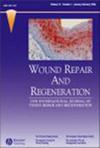一项双盲随机对照研究,比较瘢痕疙瘩患者鞘内注射维生素 D3 和鞘内注射曲安奈德的有效性和安全性及其与组织中维生素 D 受体表达的相关性。
IF 3.8
3区 医学
Q2 CELL BIOLOGY
引用次数: 0
摘要
常用于治疗瘢痕疙瘩的点内类固醇激素有皮肤萎缩和毛细血管扩张等不良反应。因此需要更安全、更有效的疗法。初步研究表明,局部注射维生素 D 是一种潜在的替代治疗方法。本研究旨在比较鞘内注射维生素 D 和曲安奈德治疗瘢痕疙瘩的疗效和安全性,并将维生素 D 受体(VDR)的组织表达与治疗效果联系起来。60名患者被随机分配到两组:A组(鞘内注射维生素D)和B组(鞘内注射曲安奈德)。每4周注射4次,随访8周。在治疗前和治疗后进行活组织切片检查,以检测 VDR 表达水平和治疗反应相关性。主要研究结果是温哥华疤痕量表(VSS)减少 50% 的患者比例。次要结果包括不良反应发生率以及治疗前后 VDR 表达的变化。基线 VSS 评分为 9.73 ± 1.01(维生素 D 组)和 10.13 ± 1.07(曲安奈德组)。治疗后,VSS 平均值降至 5.17 ± 0.59(维生素 D 组,p < 0.001)和 4.77 ± 0.77(曲安奈德组,p < 0.001),后者的反应明显更好(p = 0.03)。三苯氧胺组 VSS 评分降低 50%以上的比例更高(76.7% 对 50%,p = 0.032)。在 8 周的随访中没有发现复发。色素沉着(80% 对 36.7%,p < 0.001)和萎缩(73.3% 对 40%,p = 0.009)在曲安奈德组更为常见。两组治疗前后的 VDR 受体表达均无明显差异。三苯氧胺和维生素 D 对瘢痕疙瘩均有效。三苯氧胺的疗效更好,而维生素D更安全,这表明三苯氧胺是治疗瘢痕疙瘩的一种可行的替代疗法。本文章由计算机程序翻译,如有差异,请以英文原文为准。
A double-blinded randomised control study to compare the effectiveness and safety of intralesional vitamin D3 with intralesional triamcinolone and its correlation with tissue expression of vitamin D receptors in patients with keloid.
Intralesional steroids commonly used for keloid treatment have adverse effects like cutaneous atrophy and telangiectasias. Safer and more effective therapies are needed. Preliminary studies suggest intralesional vitamin D as a potential alternative treatment. The aim of this study was to compare efficacy and safety of intralesional vitamin D with triamcinolone for keloids, and correlate tissue expression of vitamin D receptors (VDRs) with treatment outcomes. Sixty patients were randomly assigned to two groups: Group A (intralesional vitamin D) and Group B (intralesional triamcinolone). Four injections were given at 4-week intervals, with an 8-week follow-up. Biopsies were taken pre- and post-treatment to examine VDR expression levels and treatment response correlation. The primary outcome of interest was the proportion of patients achieving a 50% reduction in Vancouver Scar Scale (VSS). Secondary outcomes included incidence of adverse effects, and changes in VDR expression before and after treatment. Baseline VSS scores were 9.73 ± 1.01 (vitamin D group) and 10.13 ± 1.07 (triamcinolone group). After treatment, mean VSS decreased to 5.17 ± 0.59 (vitamin D group, p < 0.001) and 4.77 ± 0.77 (triamcinolone group, p < 0.001), with significantly better response in latter (p = 0.03). More than 50% reduction in VSS score was higher in the triamcinolone group (76.7% vs. 50%, p = 0.032). No recurrences were noted during the 8-week follow-up. Hypopigmentation (80% vs. 36.7%, p < 0.001) and atrophy (73.3% vs. 40%, p = 0.009) were more common in the triamcinolone group. No significant difference in pre- and post-treatment VDR receptor expression was observed in either group. Both triamcinolone acetonide and vitamin D were effective for keloids. Triamcinolone was more efficacious, whereas vitamin D was safer, suggesting it as a viable alternative for keloid management.
求助全文
通过发布文献求助,成功后即可免费获取论文全文。
去求助
来源期刊

Wound Repair and Regeneration
医学-皮肤病学
CiteScore
5.90
自引率
3.40%
发文量
71
审稿时长
6-12 weeks
期刊介绍:
Wound Repair and Regeneration provides extensive international coverage of cellular and molecular biology, connective tissue, and biological mediator studies in the field of tissue repair and regeneration and serves a diverse audience of surgeons, plastic surgeons, dermatologists, biochemists, cell biologists, and others.
Wound Repair and Regeneration is the official journal of The Wound Healing Society, The European Tissue Repair Society, The Japanese Society for Wound Healing, and The Australian Wound Management Association.
 求助内容:
求助内容: 应助结果提醒方式:
应助结果提醒方式:


